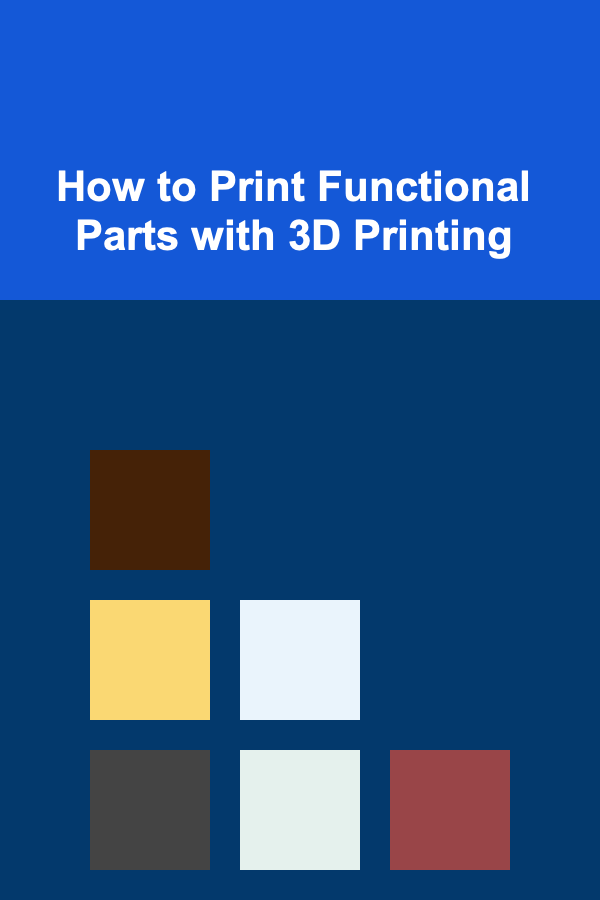
How to Print Functional Parts with 3D Printing
ebook include PDF & Audio bundle (Micro Guide)
$12.99$8.99
Limited Time Offer! Order within the next:

3D printing has revolutionized manufacturing and product design by enabling the production of functional parts with complex geometries, faster prototyping, and reduced costs. While most people associate 3D printing with creating prototypes or decorative models, it can also be used to produce fully functional parts that serve real-world purposes. The process of 3D printing functional parts involves a combination of material selection, design considerations, printer capabilities, and post-processing techniques. In this article, we'll explore the critical aspects of 3D printing functional parts and provide a comprehensive guide on how to ensure your printed parts perform effectively in their intended applications.
Understanding Functional Parts in 3D Printing
Functional parts are those that are designed to perform a specific task or job. These could range from simple components such as brackets and gears to more complex pieces like drone parts, medical devices, or automotive components. Unlike decorative prints, functional parts must meet certain performance criteria, such as strength, durability, heat resistance, and chemical resistance, depending on the application.
In many cases, the ability to print functional parts allows for a more efficient, cost-effective, and customized solution compared to traditional manufacturing methods. Additionally, 3D printing provides the flexibility to iterate quickly, optimize designs, and reduce waste, which makes it an ideal tool for both prototyping and final production.
The Role of Material Selection
Choosing the right material is one of the most important aspects of 3D printing functional parts. The material determines how the part will perform under different environmental conditions, as well as its strength, flexibility, and resistance to wear and tear. Different 3D printing technologies support different materials, each with unique characteristics suited for specific applications.
Common Materials for Functional Parts
- PLA (Polylactic Acid): PLA is a widely used 3D printing material due to its ease of use and biodegradability. However, its mechanical properties are not as strong or durable as some other materials, making it more suitable for non-load-bearing or low-stress applications.
- ABS (Acrylonitrile Butadiene Styrene): ABS is more durable and heat-resistant than PLA. It is commonly used for functional parts that require impact resistance or are exposed to moderate temperatures. ABS is often used in automotive and household applications.
- PETG (Polyethylene Terephthalate Glycol): PETG is a strong, flexible material that is resistant to impact, moisture, and UV degradation. It combines the ease of PLA with the strength of ABS, making it a great choice for functional parts that need to withstand mechanical stress.
- Nylon: Nylon is one of the strongest and most durable 3D printing materials available. It offers high tensile strength, flexibility, and wear resistance, making it ideal for parts that need to endure friction, high loads, or harsh environments.
- TPU (Thermoplastic Polyurethane): TPU is a flexible, rubber-like material that is used for parts requiring elasticity and impact resistance, such as seals, gaskets, and flexible hinges.
- Metal: For highly demanding applications that require superior strength and heat resistance, 3D printing metals such as stainless steel, titanium, and aluminum is possible with certain advanced 3D printers. Metal 3D printing is often used in aerospace, automotive, and medical fields.
Choosing the appropriate material depends on factors such as the part's mechanical requirements, environmental exposure, and the printing technology available. For example, a part that will be exposed to high temperatures may require a material like ABS or nylon, while a part that will undergo significant stress might be best suited for a metal material.
Design Considerations for Functional Parts
Designing for 3D printing is vastly different from designing for traditional manufacturing processes, such as injection molding or CNC machining. Since 3D printing allows for the creation of highly complex geometries, it is essential to account for the limitations and capabilities of the technology during the design phase.
Key Design Principles
- Strength and Structural Integrity: Functional parts must be designed with strength in mind. When designing parts for 3D printing, it's crucial to understand the material properties and how they relate to the part's function. For example, if a part needs to bear a significant load, it is essential to optimize the design to prevent weaknesses, such as thin walls or sharp corners, that could lead to failure under stress.
- Orientation and Layering: 3D printing is a layer-by-layer process, so the orientation of the part during printing can significantly affect its strength and durability. For parts that require high strength in certain directions, it is important to orient the part in a way that maximizes the strength of the printed layers. For example, a vertical orientation may result in weaker layers along the Z-axis, while a horizontal orientation may optimize strength along the X-Y axes.
- Tolerances and Fit: Functional parts often need to fit together precisely with other components. It is important to account for the dimensional accuracy and tolerances of your 3D printer and the material used. While most desktop 3D printers offer good precision, more advanced machines can achieve tighter tolerances required for engineering applications.
- Weight and Material Efficiency: In some cases, minimizing the weight of the part can be critical, especially for aerospace or automotive applications. A common technique used in 3D printing is to design hollow sections or lattice structures that reduce material usage without compromising strength.
- Post-processing Needs: Many functional parts require post-processing after printing. This can include operations like sanding, painting, polishing, or heat treating. Understanding these post-processing steps during the design process can save time and improve the final quality of the part.
3D Printing Technologies for Functional Parts
Different 3D printing technologies have different advantages when it comes to printing functional parts. The choice of technology depends on the material requirements, the size of the part, and the level of detail required.
Popular 3D Printing Technologies for Functional Parts
- FDM (Fused Deposition Modeling): FDM is the most common 3D printing technology, especially for home and office use. It works by extruding thermoplastic filament layer by layer to build up the part. While it offers good material versatility and cost-effectiveness, FDM prints may not offer the highest resolution or best surface finish for highly detailed or precise functional parts.
- SLA (Stereolithography): SLA uses a liquid resin that is cured by a laser or projector to build up the part layer by layer. This technology is known for its high resolution and smooth surface finishes. While SLA is not as commonly used for large functional parts, it is ideal for creating small, detailed components for industries such as jewelry, dentistry, and prototyping.
- SLS (Selective Laser Sintering): SLS uses a laser to sinter powdered material (typically nylon or metal), fusing it together to form the part. SLS is known for producing strong, durable parts without the need for support structures, making it ideal for creating complex geometries with high mechanical requirements.
- DMLS (Direct Metal Laser Sintering): DMLS is a metal 3D printing process that uses a laser to sinter metal powders. It is commonly used in industries like aerospace, automotive, and medical devices for printing high-performance functional parts with complex shapes and superior material properties.
- PolyJet and MultiJet Fusion: These technologies use inkjet-like print heads to deposit photopolymer or thermoplastic material layer by layer. They are capable of producing high-resolution parts with excellent surface finishes. PolyJet is particularly useful for creating prototypes with varying material properties and complex geometries.
Each of these technologies has its strengths and limitations. FDM is the most accessible for personal and small-scale manufacturing, while technologies like SLS, DMLS, and PolyJet offer higher performance but are typically used in industrial or specialized applications.
Post-processing Functional Parts
Post-processing plays a crucial role in ensuring that 3D printed parts are functional and meet their intended performance standards. Depending on the printing technology and material used, various post-processing steps may be required.
Common Post-processing Techniques
- Support Removal: Some 3D printing technologies, such as FDM and SLA, use support structures to help hold the part in place during printing. These supports need to be carefully removed after printing to ensure that the final part is clean and functional.
- Sanding and Polishing: After printing, many parts will have visible layer lines or rough surfaces. Sanding and polishing the part can improve its appearance and, in some cases, improve its mechanical properties by reducing friction or stress concentrations.
- Heat Treatment: Certain materials, such as nylon and ABS, may benefit from heat treatment after printing. Heat treating parts can improve their strength, flexibility, and resistance to environmental stress. This process involves subjecting the part to a specific temperature for a period of time to enhance material properties.
- Coating: For parts exposed to moisture, chemicals, or UV light, applying a protective coating can improve durability and longevity. Coatings such as epoxy, spray paints, or specialized varnishes can protect the part and improve its performance in demanding environments.
Real-World Applications of Functional 3D Printed Parts
3D printing of functional parts is used in a wide variety of industries, offering innovative solutions for many real-world challenges. Some of the most common applications include:
- Aerospace: Lightweight, complex components that need to withstand extreme conditions.
- Automotive: Custom parts, brackets, and tooling used in car manufacturing.
- Medical Devices: Custom prosthetics, surgical tools, and implants tailored to individual patients.
- Consumer Electronics: Custom housings, connectors, and other functional components.
- Robotics: High-performance parts like gears, motors, and actuators for robots.
The flexibility and rapid prototyping capabilities of 3D printing make it a vital tool in many industries, allowing for faster iteration, customization, and the ability to produce highly specialized components.
Conclusion
3D printing has evolved beyond rapid prototyping to become a powerful tool for manufacturing functional parts. By carefully considering material selection, design, printing technology, and post-processing techniques, engineers and designers can produce parts that meet specific functional requirements. Whether you are in aerospace, automotive, or healthcare, 3D printing allows you to create custom, high-performance components that would be difficult or impossible to produce using traditional manufacturing methods. With continuous advancements in 3D printing technologies, the future of functional part manufacturing looks bright, offering even more opportunities for innovation and efficiency.

How to Create a Checklist for Avoiding Common Tax Filing Mistakes
Read More
How to Set Competitive Rent Prices for Your Property
Read More
How to Stage Your Home for the Spring Market
Read More
The Recruitment Consultant's Playbook: Key Techniques for Attracting Top Talent
Read More
Using Deep Learning to Build a Profitable Affiliate Marketing Business
Read More
How to Prepare for Urban Exploration (Adventure)
Read MoreOther Products

How to Create a Checklist for Avoiding Common Tax Filing Mistakes
Read More
How to Set Competitive Rent Prices for Your Property
Read More
How to Stage Your Home for the Spring Market
Read More
The Recruitment Consultant's Playbook: Key Techniques for Attracting Top Talent
Read More
Using Deep Learning to Build a Profitable Affiliate Marketing Business
Read More